IEC61850标准介绍(NR)教程
- 格式:ppt
- 大小:4.09 MB
- 文档页数:2

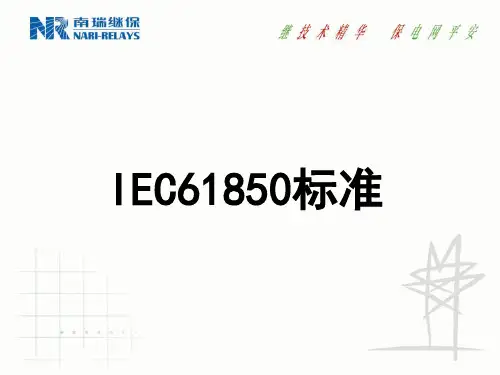
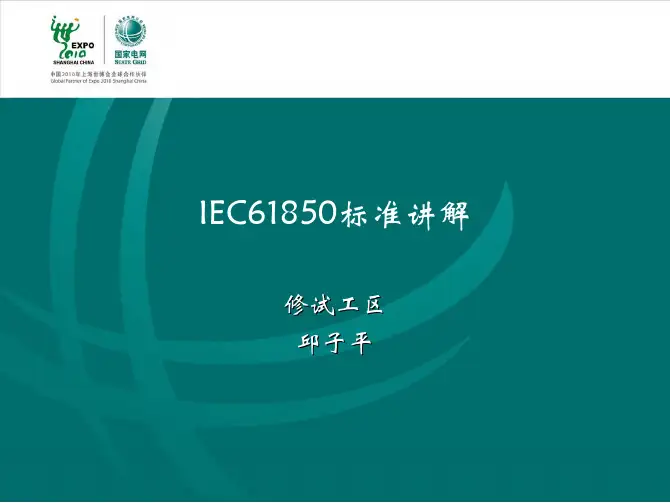
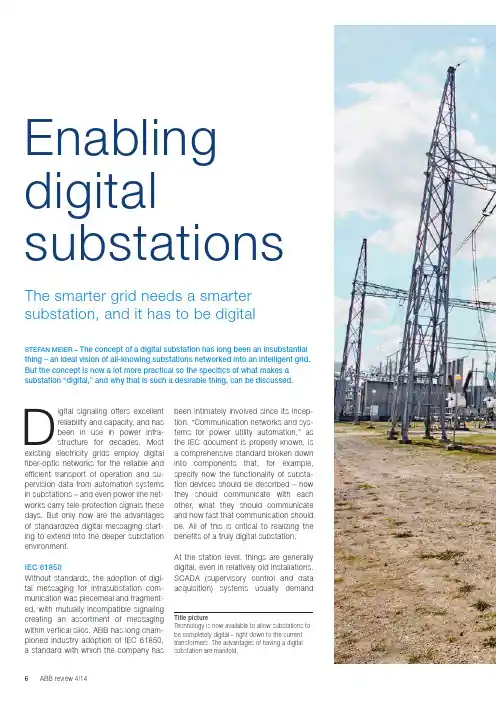
been intimately involved since its incep-tion. “Communication networks and sys-tems for power utility automation,” as the IEC document is properly known, is a comprehensive standard broken down into components that, for example, specify how the functionality of substa-tion devices should be described – how they should communicate with each o ther, what they should communicate and how fast that communication should be. All of this is critical to realizing the benefits of a truly digital substation.At the station level, things are generally digital, even in relatively old installations. SC ADA (supervisory control and data a cquisition) systems usually demand Digital signaling offers excellent reliability and capacity, and has been in use in power infra-structure for decades. Most existing electricity grids employ digital f iber-optic networks for the reliable and efficient transport of operation and su-pervision data from automation systems in substations – and even power line net-works carry tele-protection signals these days. But only now are the advantages of standardized digital messaging start-ing to extend into the deeper substation environment.IEC 61850Without standards, the adoption of digi-tal messaging for intrasubstation com-munication was piecemeal and fragment-ed, with mutually incompatible signaling creating an assortment of messaging within vertical silos. ABB has long cham-pioned industry adoption of IEC 61850, a standard with which the company has STEFAN MEIER – The concept of a digital substation has long been an insubstantial thing – an ideal vision of all-knowing substations networked into an intelligent grid. But the concept is now a lot more practical so the specifics of what makes a substation “digital,” and why that is such a desirable thing, can be discussed.The smarter grid needs a smarter substation, and it has to be digital Enabling digital substations Title picture Technology is now available to allow substations to be completely digital – right down to the currenttransformers. The advantages of having a digital substation are manifold.FOCS Robustness and reliability requirements apply to new technologies such as ABB’s fiber-optic current sensor (FOCS) too. A FOCS [1] can directly monitor current running through a high-voltage line with-out having to involve a current trans-former (CT) to step down the current to a measurable value. Eliminating the C T also eliminates the risk of open C T cir-cuits, in which life-threatening voltages can occur, and so increases safety.A FOCS exploits the phase shift in polar-ized light introduced by an electromag-netic field (the Faraday effect). The shiftis in direct proportion to the current flow-ing in the high-voltage line, around whichthe fiber carrying the light is wrapped.The measurement is digitized right atthe source and transmitted as a digitalsignal, via the process bus, to the pro-tection and control IEDs, as well as therevenue meters.Such an optical C T takes up a lot lessspace than its analog equivalent. It caneven be integrated into a disconnectingcircuit breaker (as ABB did in 2013) tocombine the functions of circuit breaker,current transformer and disconnector inone device – halving the size of a newsubstation.The FOCS is one of a range of noncon-ventional instrument transformers (NCITs)that can make things entirely digital.NCITs have to be every bit as reliable asthe equipment being replaced – and theydigital information and ABB has been selling fiber-optic “backbones” for more than two decades.Between the station level and the bays, fibers can carry digital data – conforming to IEC 61850 – but to become a true digital substation the standard has to e xtend even further.Deep digitalThe world beyond the bays is still pre-dominately analog. The conventional pri-mary equipment, like current and voltage transformers, is connected back to intel-ligent electronic devices (IEDs) using par-allel copper wires carrying analog voltage signals ➔1a. The IEDs receiving that data perform first-level analysis and often pro-vide the gateway into a digital world.But there is little advantage in keeping the data in analog form for so long and to properly earn the title of “digital substa-tion” the transition to digital must takeplace as soon as the data is gathered ➔1b.Through permanent system supervision, digital equipment reduces the need for manual intervention and the adoption of the all-digital process bus allows sensitive equipment to be relocated into the bays. The digital equipment that has to bel ocated out in the yard must be easy to fit, and every bit as robust and reliable as the analog equipment it is replacing or inter-facing to ➔2.Digital signaling offers excellent reliability and capacity, and has been in use in power infrastruc-ture for decades.1a Today 1b Tomorrow670 series 670 series REB500REB500650 series 650 seriescurrent transformer, arcing may occur as dangerously high voltages build and a copper line can suddenly carry high volt-age, putting workers and equipment at risk. Less copper brings greater safety.The digital substation dispenses with cop-per by using the digital process bus, which might use fiber optics or a wireless net-work, such as ABB’s Tropos technology.Just the removal of copper can, in some circumstances, justify the switch to digital. Going digital can cut the quantity of cop-per in a substation by 80 percent – a sub-stantial cost saving and, more importantly, a significant safety enhancement.The process bus also adds flexibility: Digital devices can speak directly to each other ➔3. For this, IEC 61850 defines the GOOSE (generic object-orientatedsubstation events)protocol for fasttransmission of bi-nary data. Part 9-2of the standard de-scribes the trans-mission of sampledvalues over Ether-net. These principlesensure the timelydelivery of high-pri-ority data via other-wise unpredictableEthernet links. ABB’s ASF range of E thernet switches fully supports this crit-ical aspect of substation messaging.are: Over the past decade ABB has sup-plied more than 300 NC ITs (combined current and voltage sensors fitted into gas-insulated switchgear) for use in Queensland, Australia, and the utility has yet to see a single failure in the primarysensor. Extensive use of NCITs makes a substation simpler, cheaper, smaller and more efficient.Not everything can be digital – analog data will continue to arrive from conven-tional current and voltage transformers, for example. But there is no reason for wholesale replacement when a stand-alone merging unit can perform the tran-sition to digital right beside the existinginstrument transformer. Fiber optics can then replace the copper cables connect-ing the primary equipment to the protec-tion and control IEDs.Process bus As a conductor, every bit of copper in a substation is a potential risk. For exam-ple, where current is incorrectly discon-nected, such as with an open secondary A FOCS can direct-ly monitor current running through a high-voltage line without having to involve a current transformer to stepdown the current to a measurable value.2 New equipment destined for use out in the yard is exposed to the elements so has to be very robust.ABB has long championed industry adoption of IEC 61850, a standard with which the company has been intimately involved since its inception.Installations ABB has been heavily involved in IEC 61850 since its inception. The stan-dard is essential to ensure that utilities can mix and match equipment from dif-ferent suppliers, but, through compli-ance testing, it also provides a bench-mark against which manufacturers can be measured.ABB deployed the first commercial IEC 61850-9-2 installation in 2011 at the Loganlea substation, for Powerlink Queens-land. The use of ABB’s IEC 61850-9-2- compliant merging units and IEDs, not to mention NCITs, makes the deployment a landmark in the evolution of substation design.That project was part of an upgrade of an existing station, an upgrade that saw it move into an IEC 61850 future, adopting digital standards for effective future-proof-ing. ABB created a retrofit solution based on specifications from Powerlink that can be applied to another five Powerlink substa-tions when they are ready for refitting.Two of those stations, Millmerran and Bulli Creek, were already upgraded in 2013 and 2014, respectively. The refurbished sub-stations have a MicroSCADA Pro SYS600 system and RTU560 gateway that manage Relion 670 protection and control IEDs, with REB500 busbar protection. These all communicate over IEC 61850-9-2 to the merging units and over IEC 61850 to the station-level devices. A fully digital substation is smaller, more reliable, has a reduced life-cycle cost and is simpler to maintain and extend than an analog one. It offers increased safety and is more efficient than its ana-log equivalent.Not every substation needs to be cata-pulted into a wholesale digital world – it depends on the substation size and type, and whether it is a new station or a retrofit of the secondary system. Different ap-proaches and solutions are required. ABB’s extensive IEC 61850 experience and portfolio of NCITs, merging units, pro-tection and control IEDs as well as station automation solutions eases utilities into the digital world. Flexible solutions allow utilities to set their own pace on their waytoward the digital substation.3 IEC 61850 makes the fully digital substation a reality.Stefan MeierABB Power Systems Baden, Switzerland *******************.com An optical CT takes up a lot less space than its analog equivalent and can even be integrated into a disconnecting circuit breaker to combine the func-tions of circuit breaker, current transformer and disconnector in one device – halv-ing the size of a new substation.Reference [1] S. Light measures current – A fiber-optic current sensor integrated into a high-voltage circuit breaker. Available: /global/scot/scot271.nsf/veritydisplay/0d948cedb40451cec1257ca900532dd0/$file/12-17%201m411_EN_72dpi.pdf。
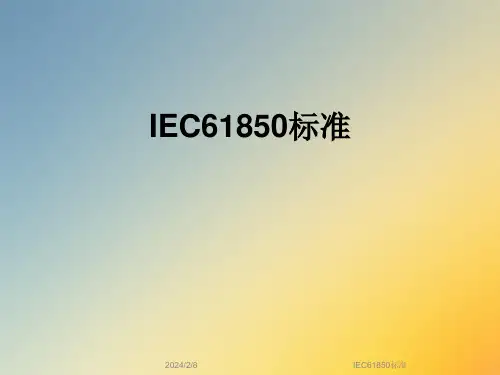
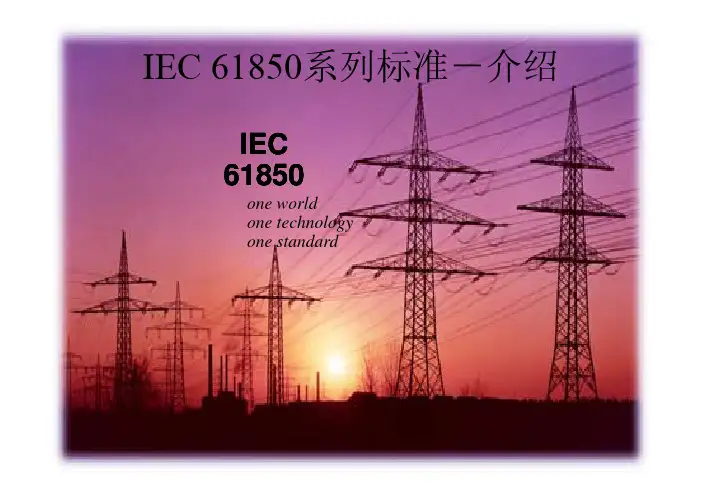
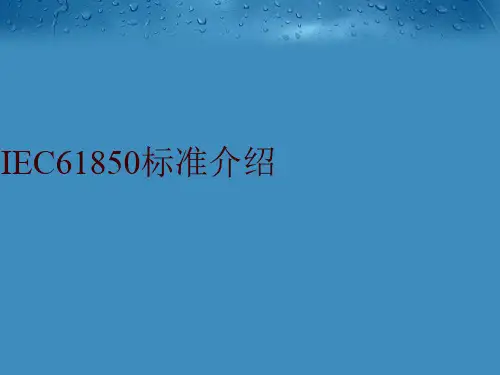
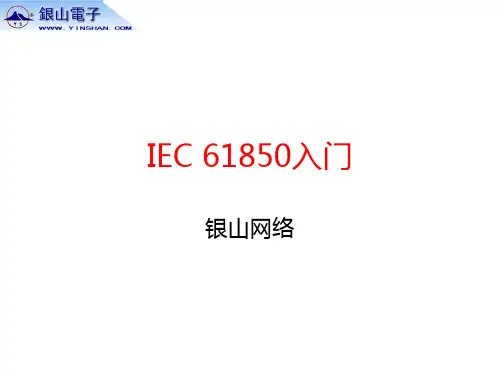
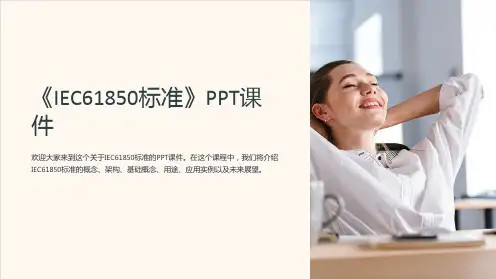
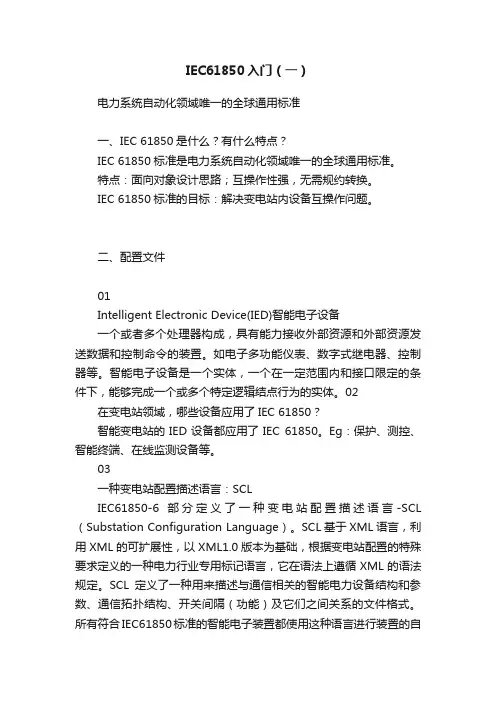
IEC61850入门(一)电力系统自动化领域唯一的全球通用标准一、IEC 61850是什么?有什么特点?IEC 61850标准是电力系统自动化领域唯一的全球通用标准。
特点:面向对象设计思路;互操作性强,无需规约转换。
IEC 61850标准的目标:解决变电站内设备互操作问题。
二、配置文件01Intelligent Electronic Device(IED)智能电子设备一个或者多个处理器构成,具有能力接收外部资源和外部资源发送数据和控制命令的装置。
如电子多功能仪表、数字式继电器、控制器等。
智能电子设备是一个实体,一个在一定范围内和接口限定的条件下,能够完成一个或多个特定逻辑结点行为的实体。
02 在变电站领域,哪些设备应用了IEC 61850?智能变电站的IED设备都应用了IEC 61850。
Eg:保护、测控、智能终端、在线监测设备等。
03一种变电站配置描述语言:SCLIEC61850-6部分定义了一种变电站配置描述语言-SCL (Substation Configuration Language)。
SCL基于XML语言,利用XML的可扩展性,以XML1.0版本为基础,根据变电站配置的特殊要求定义的一种电力行业专用标记语言,它在语法上遵循XML的语法规定。
SCL定义了一种用来描述与通信相关的智能电力设备结构和参数、通信拓扑结构、开关间隔(功能)及它们之间关系的文件格式。
所有符合IEC61850标准的智能电子装置都使用这种语言进行装置的自我描述,对整个变电站自动化系统的配置描述同样也基于SCL。
3.1 SCL语言示例04配置文件配置文件是利用SCL语言描述变电站设备对象模型后生成的文件,用于在不同厂商的配置工具之间交换配置信息。
通过一系列配置文件的传递,不同厂商的智能设备就知道对方通信所需要的的数据信息,从而实现通信双方配置信息的交换。
为了区分在不同工具间交换的数据类型,定义了不同的配置描述文件。
SCL配置文件共分为几类,分别以ICD、CID、SSD、SCD、CCD为后缀进行区分,必须满足SCL.Xsd的约束并且通过其校验。
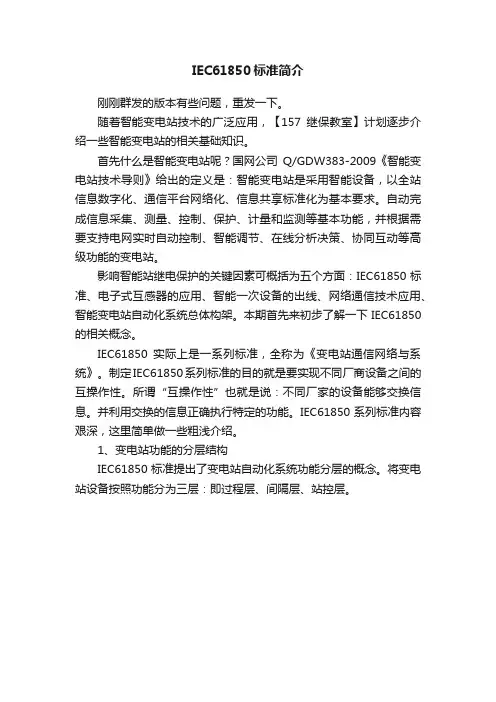
IEC61850标准简介刚刚群发的版本有些问题,重发一下。
随着智能变电站技术的广泛应用,【157继保教室】计划逐步介绍一些智能变电站的相关基础知识。
首先什么是智能变电站呢?国网公司Q/GDW383-2009《智能变电站技术导则》给出的定义是:智能变电站是采用智能设备,以全站信息数字化、通信平台网络化、信息共享标准化为基本要求。
自动完成信息采集、测量、控制、保护、计量和监测等基本功能,并根据需要支持电网实时自动控制、智能调节、在线分析决策、协同互动等高级功能的变电站。
影响智能站继电保护的关键因素可概括为五个方面:IEC61850标准、电子式互感器的应用、智能一次设备的出线、网络通信技术应用、智能变电站自动化系统总体构架。
本期首先来初步了解一下IEC61850的相关概念。
IEC61850实际上是一系列标准,全称为《变电站通信网络与系统》。
制定IEC61850系列标准的目的就是要实现不同厂商设备之间的互操作性。
所谓“互操作性”也就是说:不同厂家的设备能够交换信息。
并利用交换的信息正确执行特定的功能。
IEC61850系列标准内容艰深,这里简单做一些粗浅介绍。
1、变电站功能的分层结构IEC61850标准提出了变电站自动化系统功能分层的概念。
将变电站设备按照功能分为三层:即过程层、间隔层、站控层。
过程层主要功能是将交流模拟量、直流模拟量、状态量就地转化为数字信号提供给上层,并接受和执行上层下发的控制命令。
过程层设备包括一次设备及其智能组件。
间隔层主要功能是采集本间隔一次设备的信号,控制操作一次设备,并将相关信息上送给站控层设备和接受站控层设备的命令。
间隔层设备由每个间隔的控制、保护、监视装置组成、站控层主要功能是实现对全站一次、二次设备进行监视、控制以及与远方控制中心通信。
站控层设备包括监控主机、远动工作站、操作员工作站、对时系统等。
逻辑接口可以采用几种不同的方法映射到物理接口。
一般可用站级总线覆盖逻辑接口1、3、6、9,采用过程总线覆盖逻辑接口4、5。